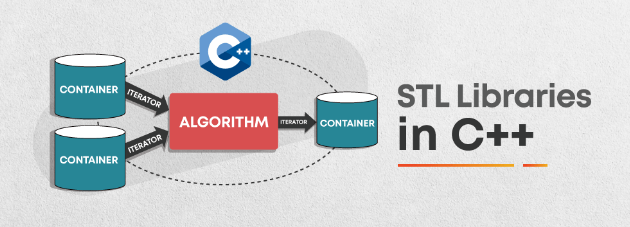An Introduction to STL Libraries in C++
 Praachi Rasane
Praachi Rasane
C++ is a powerful programming language that provides a wide range of features and functionalities. One of the most useful features of C++ is the Standard Template Library (STL). The STL is a collection of reusable data structures and algorithms that are implemented in C++ and are part of the C++ Standard Library.

Purpose of STL Libraries
The purpose of the STL is to provide a set of generic programming tools that can be used to solve a wide range of problems. The STL provides a set of powerful data structures such as vectors, lists, maps, and sets, as well as a set of algorithms that can be used to manipulate these data structures. The data structures provided by the STL are designed to be efficient and easy to use, while the algorithms provided by the STL are designed to be generic and flexible.
How to Use STL Libraries
To use the STL, you need to include the appropriate header files in your C++ program. For example, to use the vector data structure, you need to include the <vector> header file. Once you have included the appropriate header file, you can use the data structures and algorithms provided by the STL in your program.
Here is an example of how to use the vector data structure provided by the STL:
#include <vector>
#include <iostream>
int main()
{ std::vector<int> myVector;
myVector.push_back(1);
myVector.push_back(2);
myVector.push_back(3);
for (int i = 0; i < myVector.size(); i++)
{ std::cout << myVector[i] << std::endl; }
return 0;
}
In this example, we first include the <vector> and <iostream> header files. We then declare a vector called myVector that holds integers. We add three integers to the vector using the push_back() function, and then we use a for loop to print out the contents of the vector.
Advantages of STL Libraries
There are several advantages of using the STL in your C++ programs.
Firstly, the STL provides a set of powerful and efficient data structures and algorithms that can be used to solve a wide range of problems. These data structures and algorithms are designed to be generic and flexible, which means that they can be easily adapted to different situations.
Secondly, the STL is part of the C++ Standard Library, which means that it is widely supported by different compilers and platforms. This makes it easy to write portable code that can be used on different systems.
Finally, the STL is well-documented and has a large user community, which means that it is easy to find help and resources when you need them.
Conclusion
The STL is a powerful and flexible set of libraries that can be used to solve a wide range of programming problems. Whether you are working on a small project or a large-scale application, the STL provides a set of tools that can help you get the job done efficiently and effectively. By learning how to use the STL, you can become a more productive and effective C++ programmer.
About the Author:
I am Praachi Rasane, an upcoming software engineer. I have elementary expertise in Python, C++ and C programming languages. I would love to level up my knowledge as I pave a path for novice learners to understand concepts in these languages better.
Throughout my early years, I've always had a passion for writing. Apart from technical writing, I have immersive love for fantasy fiction and Sci-fi. For further interests, you can reach out to me on my Social Media handles.
LinkedIn:https://www.linkedin.com/in/praachi-rasane-760455269/
Instagram:https://instagram.com/praachi15?igshid=MzNlNGNkZWQ4Mg==
Subscribe to my newsletter
Read articles from Praachi Rasane directly inside your inbox. Subscribe to the newsletter, and don't miss out.
Written by
